On our Uganda Safari Mountain Gorilla Trekking Women’s Travel Group Tour one of the highlights is participating in rhino trekking at the Ziwa Rhino Ranch and Sanctuary. It is a project run by the Uganda Rhino Fund in an effort to re-introduce rhinoceros into the wild in Uganda, at the Murchison Falls National Park. For our participants, it is the first time to get out of the safari vehicle to step into the African Bush. This walk is could be a scene right out of the movie Jurassic Park in search of modern-day giants.
The sanctuary is over 20,000 acres. The rhinos are free to roam the sanctuary. When we arrive at the property, we will drive with the rangers to where the rhinos are located. Then we gather around our ranger guides who will tell us how to enter the sanctuary safely. The rules are no flash photography, no yelling, no running, and always follow the instructions of your guide. If the rhino charges you, get behind a tree.
Trekking clothes include long sleeve shirts, long pants tucked into socks, and sturdy hiking boots. Colors should be forest friendly like tan, dark green, brown, or maroon to not spook animals. Always avoid navy blue or black in African grasslands to not attract Tetsy flies. A wide-brim hat and sunglasses will protect trekkers from the intense equatorial sun. A small backpack for cameras, binoculars, water bottles, and rain jacket is recommended for other essentials and will free up your hands during the walk.

Participants getting a safety briefing before rhino trekking.
Throughout rhino trekking participants are walking among free roaming rhinoceroses in their habitat. The ranger leads us through game trails in various habitats. The ground is uneven. The grass is long and sharp, and the trees are short and sometimes thorny. In addition to finding some of the 22 Southern White Rhinos individuals that live here, we will be on the lookout for Ugandan Kob, Bushbuck, Armadillos, Honey Badgers, and even Leopards.

Walking through grasses and scrub.
As we walk through the property, the rangers tell us interesting information and stories about the sanctuary and the individuals that live there. Most of the rhinos came from Kenya, and one of them was donated by Disney. The sun is usually intense, and the air temp is hot. The whole trekking experience is about 2 hours with frequent stops. The ranger will help you identify signs that the rhinos leave behind in the environment that let us know a crash (group of rhinos) were in the area. Some signs are small, like footprints and chewing. The biggest and most obvious signs are dung middens which are communal toilets. The dung middens are like giant piles of notes left for others in the group. Individuals can sniff the dung and translate the chemical trail to determine who is ready to mate, who is more dominant, whose territory this is, and where food is located. Males will drag their back fee through these piles to drag odors and to advertise their presence. A middens can be huge, over 65ft long.
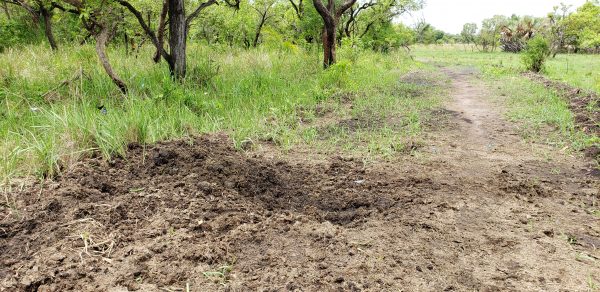
Rhino middens are communal toilets and abundant in the sanctuary.
Surprisingly, rhino dung does not smell bad. It is made up mostly of grasses. The white rhino’s large head is too heavy to lift up for extended grazing of shrubs and high grass. This species has adapted to eating short grasses of the savannah. Whereas, Black Rhinos eat more woody and shrubby vegetation. In areas where both black and white rhinos co-exist, the dung middens of the two species can be determined by woody branches in Black Rhino dung and not in White Rhino dung. These middens contribute to the fertilization of grasslands and provide food for animals like Dung Beetles and Ringbanded Swallowtail Butterflies.

White Rhino footprint and foot drag.
Once we see our first rhinos, your ranger guide will determine how closely the group can approach. Here you can watch rhinos on the range and a look for a variety of natural behaviors. You may find rhinos sleeping under the shade of some trees or grazing out in the open grassland. Rhinos are excellent diggers as they forage on the grassland. Near every rhino individual, there are usually birds like egrets and Oxpeckers who take advantage of the insects kicked up by rhinos or parasites that land on their skin. With noisy cicadas and other sounds of the grassland, it might be difficult to hear their communication, but rhinos are vocal and will use grunts and groans to communicate with each other.
In 2019, a baby had been recently born and it was beautiful to watch it nurse and interact with its mother. Babies are born every two and a half years and will stay with their mothers for about three years to nurse and for protection. The mother’s milk is low in fat due and high in carbohydrates. The calves can graze within two months. Their only predators are big cats and crocodiles. When White Rhinos flee the baby runs in front of the mother, for Black Rhinos, the baby runs behind the mother.
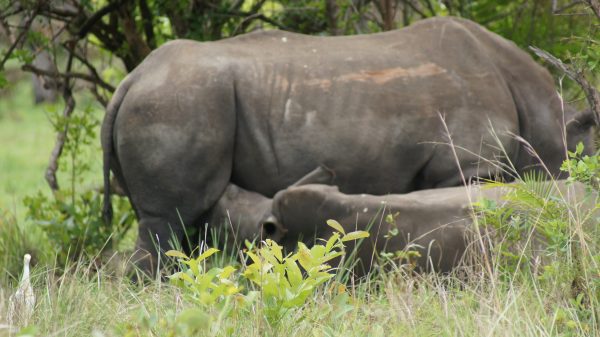
Baby White Rhinoceros nursing.
Fossil records indicate that modern rhinoceroses evolved from the order Perissodactyla, that includes herbivorous mammals with one or three hooved toes on each hind foot. Members of this order include horse and tapir (Encyclopedia Britannica). Three families of rhino relatives evolved from the order and were distributed throughout the world including the Americas & Eurasia. One family included the “running rhinos” of Eurasia, that looked more like horses than modern rhinos. The smallest was dog-sized, and the largest was giraffe-like, and holds the record of the largest known land animal. Paraceratherium was 21ft tall, 30ft long, and weighed as much as 3 school busses. A second family included the aquatic rhinos which were found in North America and Eurasia. They were hippopotamus-like and in and near lakes and rivers. The third family, the Rhinocertoida is more likely the closest relative to rhinos we know today. It was made up of 26 different genera. Most of the smaller species of rhinos went extinct during the Pliocene about 2.5-5 billion year ago. A few larger species including the wooly rhino survived the last ice age. Fossil records were found in Siberia and dated to 200,000 years ago. The animal was 6ft tall, 15ft long, and estimated to be 10,000 pounds (Wikipedia).
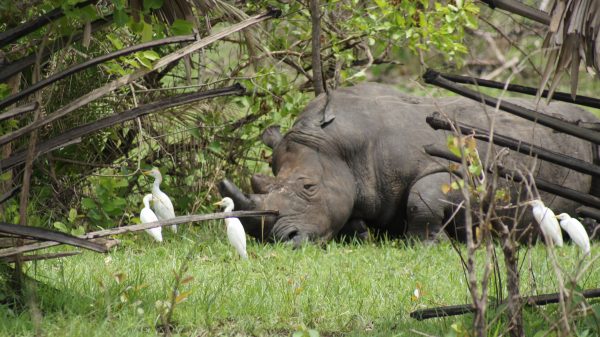
A rhino sleeping at Ziwa Ranch.
Today there are four species of rhinoceros that range from Africa, India, and Asia. In Africa, there are two species of Rhinoceros: Black rhinos with four sub-species, and White rhinos with two sub-species. 150 years ago, there were over one million Black and White Rhinos living in Africa! Imagine historic plains thick with herds grazing under African sun. As of 2022 there are only about 6,195 Black rhinos, and 20,000 Southern White rhinos left in the world.
The guide will continue to approach the rhinos with the safety of the group in mind. Rhinos are prehistoric looking, and resemble the Triceratops dinosaur, but they are mammals, not reptiles like the dinosaurs. All mammals give live birth, are warm blooded, nurse their young, and have hair. Rhinos are the second largest land mammal to the elephant. Within Africa, White rhinos are bigger than Black rhinos. White rhinos also have a large hump on their backs in order to lift their heavy heads. The White Rhino can grow to be 4,000lbs – 5,000lbs with males being larger than females. They can stand 6-7ft tall at shoulder height and can be 11-15ft in length.
Despite being a big in stature, they have relatively small brains in that big head. Where they lack in brains, they make up in brawn and agility. They can maneuver quickly and gallop 30-40 miles per hour. Rhinos do not see very well, but they have great hearing and sense of smell. When the feel threatened, they will charge, and the horn can be used for defense.
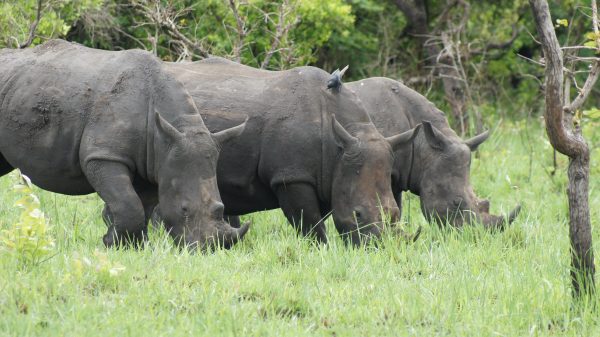
A cash of white rhinos and an Oxpecker.
Both rhinos have horns. This should go without saying because the name Rhinoceros literally translates from Ancient Greek words “rhino” and “keras” to the English meaning of “horn on nose”. The horn is made of Keratin, the same material as our hair and nails. So why are these animals killed for their horns? There are cultures in Asia that believe ground up rhino horn will help with various conditions from hangovers to impotence. Because of the perceived medicinal value, a rhino horn is like that of gold in some of these places, and as a result is the leading cause of the species’ demise.
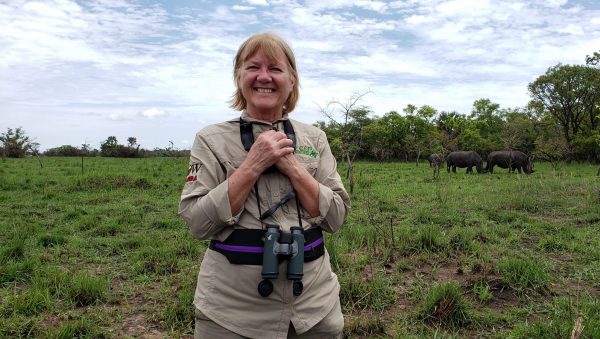
It is a life-changing experience to see be in the company of rhinos.
One of the most obvious characteristics of the rhinoceros other than their horns is their skin. The skin is very thick skin to protect them from sharp grasses and thorns. All rhinos have grey skin, so why do they have different color names? There are a couple of theories. It is thought that Black rhinos were called black because they roll in the mud and coat themselves for the natural sunblock and insect repellant. This dark mud made their skin look black. White rhinos may have been named this due to a mispronouncing of the Afrikaans word for wider. One of the identifying features of the White Rhino vs the Black Rhino is a square shaped mouth that is “wider” than the Black Rhino’s narrow mouth with prehensile lips.
As one of the Big Five, rhinos are on every tourist must-see list on safari. However, they also very important to keeping the ecology of Africa’s grasslands in balance. They are described as selective lawnmowers, and graze only on certain species of grass which promotes biodiversity. The Black rhinos contribute to pushing back woody vegetation which allows the grasslands to thrive instead of allowing trees and forests to take hold.
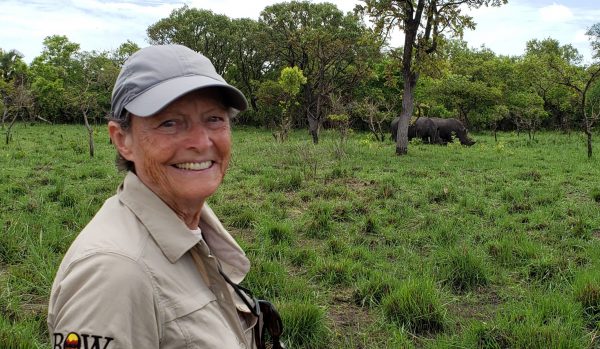
Trekking at Ziwa in search of rhinos.
Wild rhinos went extinct in Uganda in 1983 due to civil war that cause economic unrest resulting wide-spread poaching. Today, Africa’s rhinos are critically endangered with some sub-species already extinct such as the Western Black Rhino, and functionally extinct such as the Northern White rhino with just two females left to represent the species. Rhinos have no natural predators, there only threat are humans. Currently they are threatened by urban development which causes habitat loss, but their population is declining mostly from poaching.
Rhinos are protected day and night at the Ziwa ranch. There is no hunting allowed of any species. The pastoral community uses the same land as the rhinos to graze their cattle. The agreement is simple; there must be enough grass remaining for the rhinos, and if the herders see any strange activity or news within the community about poaching, they will report it to the authorities.

Uganda Kob rests under a tree. Cattle are in the background. All share the sanctuary with the White Rhinoceros.
Places like the Ziwa Rhino Sanctuary are so important to helping to protect the rhinos. Not only is the project supported by tourism dollars in exchange for tourist to get to experience a life-changing encounter with rhinos, tourism helps give jobs to local people as guides and rangers. It contributes to protecting large amounts of land for charismatic wildlife but impacts the whole ecosystems and the delicate balance of plants and animals that are needed to sustain life. Tourism dollars support hotels, souvenir shops, restaurants, guides, transportation services, and others which in turn help people support their families.
If you would like to help the African Rhinoceroses you can:
Join us in Uganda! Click here to see our Uganda Safari Mountain Gorilla Trekking Women’s Travel Group Tour
Make a donation to Grassroots Efforts in Uganda
Uganda Rhino Fund: https://www.rhinofund.org/
Support Conservation and Breeding Efforts in the USA:
Visit a rhinoceros at an AZA Accredited Zoo near you.
Support Ethical Rhino Tourism:
Join Green Edventures in Uganda on safari. Each year we lead a women’s trip in partnership with International Becoming an Outdoors Woman. Visit our destination page to see all available options: https://greenedventures.com/destinations/uganda-africa/

